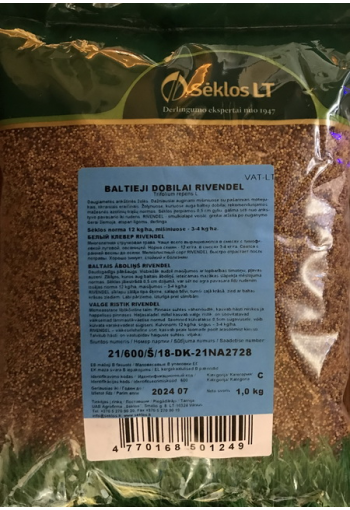Small-leaf clover, better known as microclover, is a professional revolutionary discovery of breeders that solved the problems of trampling and frequent mowing.
Differs from the traditional lawn in slow growth, wear resistance, drought resistance, attractive appearance. Saturates the soil with nitrogen, tolerates low mowing well (minimum height - 3-4 cm, maximum - 10-12 cm).
The dense growth of microclover provides protection from weeds.
This miniature plant (up to 5 cm) can be sown in its pure form and combined with any variety of lawn grasses. Sowing can be carried out throughout the season, but it is advisable to complete the sowing work before the end of August.
After sowing, the seeds must be embedded in the soil with a rake. Before germination, crops are regularly watered.
Clover blooms only in the second year, twice during the warm season: from May to October. Good honey plant.
With proper care, a clover lawn can not be updated for 7-8 years.
Seeding rate 8-10 g/m2.
* Elite varieties of clover promise the perfect bright coverage that can outshine the beauty of a simple lawn. And ten times easier to create. In practice, sowing white clover for a lawn is not much different from cereals. But on the other hand, vitality, lacy leaves, modest care requirements, versatility and accessibility for many make white clover a dream plant. Just a couple of haircuts and waterings and a smooth, lush carpet coverage will pay off all the effort.
Trifolium repens is a low, creeping perennial up to 10 cm high. Powerful creeping roots make the plant not only hardy, but also contribute to effective soil fixation.
White clover bushes better than other types of clover, spreads well and evenly. In the first months it develops reluctantly, but then quickly gains vegetative mass. Shoots take root in the soil, allowing the plant to quickly fill the free area. Bright green, with white spots, trifoliate leaves with ovate lobes merge into a dense and uniform carpet.
The flowering of a properly cared for clover lawn stretches from May until the onset of cold weather and occurs in several waves. But in order for the lawn to still become flowering, you will have to wait a bit: white clover blooms only from the second year after sowing.
Almost perfectly round inflorescence heads consist of almost a hundred tubular flowers and look very decorative. Today, white clover is often included in mixtures with cereals. The presence of 5-7% of these seeds in the composition does not make the lawn clover. Mixed carpets need to be cared for in the same way as regular lawns. And if there are rolled lawns with white clover on sale, we are talking about such “blotches”: because of the powerful roots in a rolled form, it is impossible to grow a clover lawn.
Advantages and disadvantages of white clover lawn.
The main advantages of white clover as a lawn:
good recovery after trampling and injuries;
weather resistance, less sensitivity to adverse temperatures and humidity;
frost resistance;
the ability to grow on almost any soil, showing the properties of all green manure from the Legume family;
minimal care;
resistance to diseases and pests;
decorative from early spring to late autumn;
clover lawn serves as a constant source of mulch, fodder and green manure;
self-healing due to rooting of shoots and self-seeding.
Cons of White Clover Lawn:
between the waves of flowering and in case of untimely mowing, it easily loses its decorative effect and neatness;
stylistic limitation;
after a haircut, it looks unattractive for a week;
the coating is slippery, and after precipitation it is dangerous;
the lawn attracts honey plants and insects, increasing the risk of bites;
clover easily spreads beyond the boundaries of the territory allotted to it: shoots can take root where they are inappropriate, for example, in a garden bed or flower bed, and its self-sowing is quite active.
Where can clover lawn be used?
Among alternative lawns designed for well-lit areas, white clover is one of the most versatile.
It cannot be classified as a ceremonial view: it is rather a background and landscape option for natural design. White clover can be used both as a decorative option and as a ground cover plant for fixing the soil - landscaping slopes and slopes, decorating rockeries and alpine hills, playing around with complex terrain.
White clover lawn can be used to mask bald spots, fill voids, temporary landscaping, staged arrangements, as a decorative alternative to conventional green manure when laying a new garden and re-arranging the site.
It is suitable for landscaping tree trunks, covering paths, grassing and turfing under large plants and hedges. For playgrounds, it is good because of its softness, but it is not always convenient because of insects and long shoots that are easy to catch on.
White clover. Bot. syn.: Amoria repens (L.) C.Presl.











